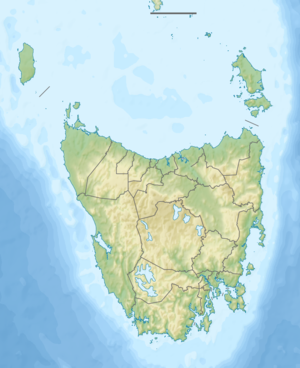Lake Pedder
| Lake Pedder | |||||||||
|---|---|---|---|---|---|---|---|---|---|
| The lake in 1970 before the dams were built | |||||||||
|
|||||||||
|
|
|||||||||
| Coordinates | 42 ° 55 '13 " S , 146 ° 10' 25" E | ||||||||
| Data on the structure | |||||||||
| Construction time: | 1967-1972 | ||||||||
| Height of the barrier structure : | 17 m / 38 m / 43 m | ||||||||
| Data on the reservoir | |||||||||
| Altitude (at congestion destination ) | 309 m | ||||||||
| Water surface | 270 km² | ||||||||
| Reservoir length | 24 km | ||||||||
| Reservoir width | 27 km | ||||||||
The Lake Pedder is an artificial lake in the southwest of the Australian state of Tasmania .
Originally a glacier lake with a size of three square kilometers that was formed 10,000 years ago, it was dammed in 1972. Today it has a size of 242 square kilometers, making it the freshwater lake in Australia with the largest volume. There were numerous unsuccessful protests against the construction of this dam.
The name of the lake comes from Tasmania's first attorney general, John Pedder . A Lake Pedder National Park was established in 1955 and later renamed Southwest National Park .
Dam construction
The lake is artificially dammed by three dams, the 38 m high serpentine dam , the 43 m high Rock-Fill dam and the 17 m high Edgar dam . The Serpentine River and the Huon River flow from the lake . The dams were built to generate electricity.
Protest movement
The protests against the reservoir planned by the Tasmanian government began in 1967 because the lake was in the Southwest National Park, a nature reserve. The Lake Pedder Action Committee was then formed . Some members of the committee later founded the world's first "Green Party", the United Tasmania Group . Later this went on in the Tasmanian Greens . A prominent opponent of the project was the Tasmanian politician Michael Hodgman .
The Hydro Tasmania (HEC), however, pushed through the construction against the growing protests of the environmentalists, which had spread across Tasmania and Australia.
Despite the failure to prevent the dam project, the Wilderness Society was formed in Tasmania . Today she is active all over Australia and, thanks to her experience at Lake Pedder, she was able to prevent the construction of the Franklin Dam .
In 1994 the Lake Pedder Restoration Committee was founded , which calls for the demolition of the dams.
Ecological consequences
The endemic worm Hypolimnus pedderensis could no longer be detected after the lake was flooded. The endemic planaria Romankenkius pedderensis , which was also believed to be lost, was only recently found. The freshwater fish Galaxias pedderensis (Pedder galaxias) only exists in human care. Probably the main cause of its disappearance in the lake is the re-enactment of trout. The sandy beaches of the original Lake Pedder are now under water.
panorama
Web links
- Lake Pedder at utas.edu.au
- Location of Lake Pedder on Hydro Tasmania
- Lake Pedder Actions Committee
- Panorama of new Lake Pedder - Photographer
- Pedder Lake Ecology (PDF; 190 kB)
swell
- Lake Pedder - TAS . ExplorOz.com
- Map of Lake Pedder, TAS . Bonzle.com
- Steve Parish: Australian Touring Atlas . Steve Parish Publishing, Archerfield QLD 2007. ISBN 978-1-74193-232-4 . P. 58
Individual evidence
- ^ Lake Pedder Restoration Committee , accessed January 10, 2010.
- ^ IUCN Red List of Threatened Species: Hypolimnus pedderensis , accessed January 10, 2010
- ↑ Forteath, GNR and Osborn, AW (2012): Survival of endemic invertebrates of Lake Pedder and Lake Edgar subsequent to inundation. Records of the Queen Victoria Museum, No. 116
- ↑ Information about the Pedder Galaxias , accessed on January 10, 2010



